The document contains lecture notes on one-dimensional and two-dimensional arrays in C programming. It discusses the syntax, declaration, initialization, and accessing of array elements. Examples are provided to demonstrate reading input from users, traversing arrays using for loops, and performing operations like addition and multiplication on two-dimensional arrays. Class exercises described include programs to read and display arrays, find the highest number in an array, and perform matrix addition and multiplication using two-dimensional arrays.

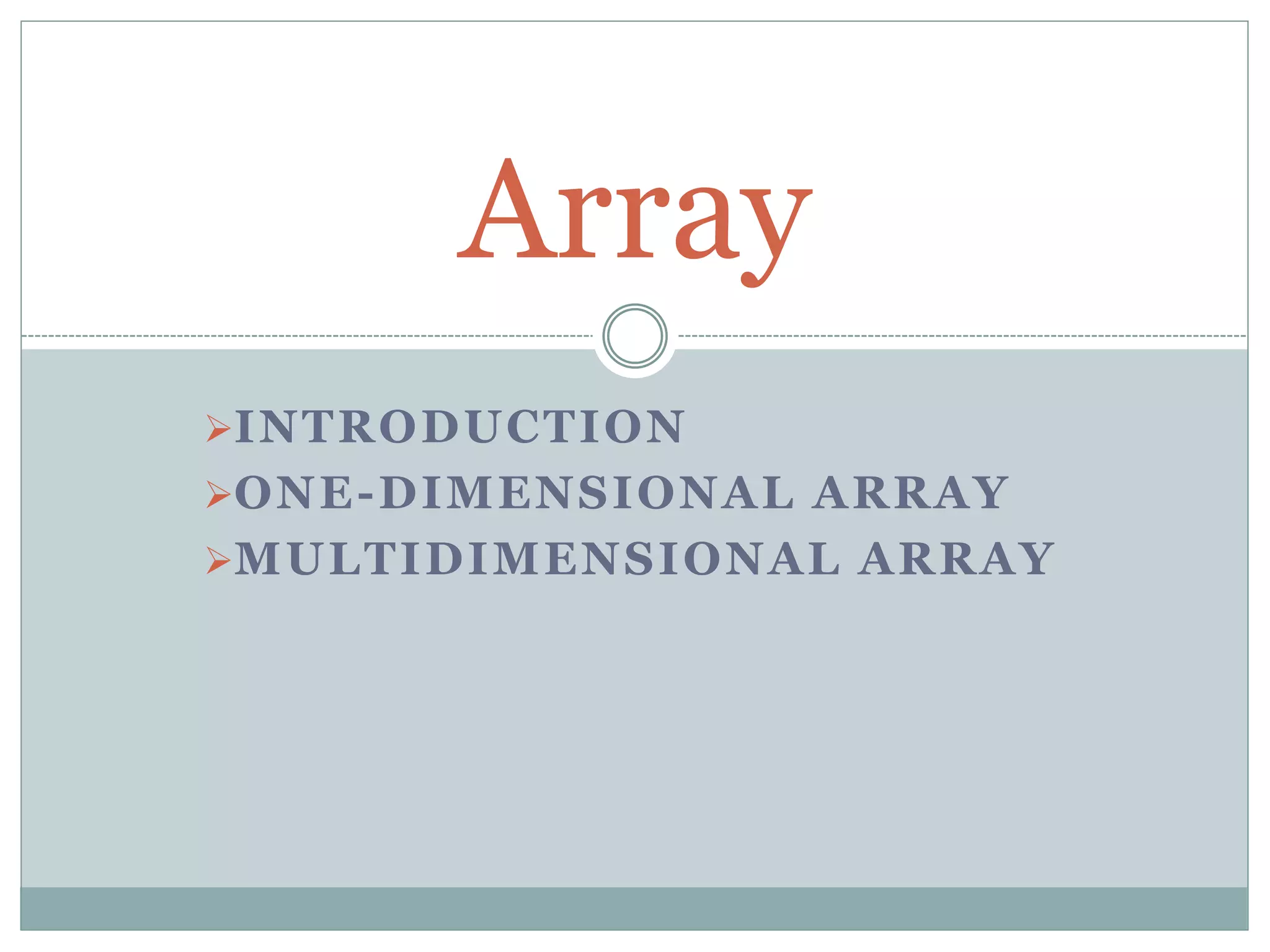
![Introduction An array is a sequence of homogenous elements It holds multiple values of same type. Each block of array is stored consecutively in memory. SYNTAX: data-type name[size]; Example: int a[6]; Arrays always start with 0 and end with [size-1]](https://image.slidesharecdn.com/array-170824170507/75/Array-MULTI-ARRAY-IN-C-3-2048.jpg)
![One dimensional Array An array is a data structure consisting of a collection of elements (values or variables), each identified by at least one array index SYNTAX: data-type name[index]; EXAMPLE: int num[10];](https://image.slidesharecdn.com/array-170824170507/75/Array-MULTI-ARRAY-IN-C-4-2048.jpg)
![Initialization int num[6]={2,4,6,7,8,12}; Individual elements can also be initialize as: num[0]=2; num[1]=4; num[2]=6; num[3]=7; num[4]=8; num[5]=12; A specific element in an array is accessed by an index.](https://image.slidesharecdn.com/array-170824170507/75/Array-MULTI-ARRAY-IN-C-5-2048.jpg)
![Arrays: Example #include<stdio.h> #include<conio.h> int main() { int age[3]; age[0] = 25; age[1] = 30; age[2] = 35; for (int j=0; j<3; j++) printf("%dn",age[j]); getch(); } 25 30 35 age[1] age[0] age[2]](https://image.slidesharecdn.com/array-170824170507/75/Array-MULTI-ARRAY-IN-C-6-2048.jpg)
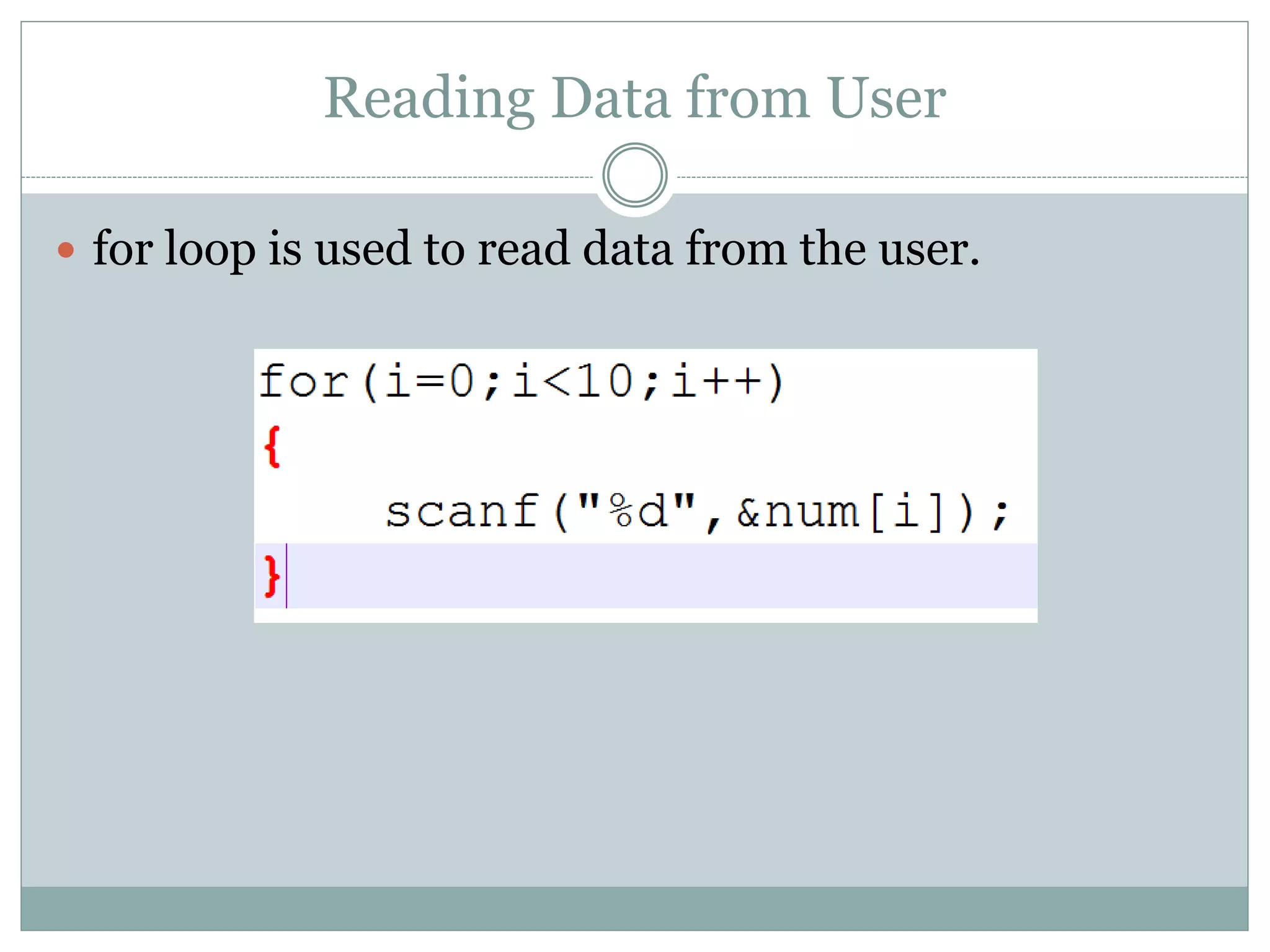
![Arrays: Example #include<stdio.h> #include<conio.h> int main() { int age[3]; age[0] = 25; age[1] = 30; age[2] = 35; printf("Ages are "); for (int j=0; j<3; j++) printf("%dn",age[j]); getch(); } #include<stdio.h> #include<conio.h> int main() { int age[3]; for (int i = 0; i<3; i++) { printf("Enter ages n"); scanf("%d",&age[i]);} printf("Ages are "); for (int j=0; j<3; j++) printf("%d n",age[j]); getch(); }](https://image.slidesharecdn.com/array-170824170507/75/Array-MULTI-ARRAY-IN-C-8-2048.jpg)
![Initializing Arrays in Declarations • Possible to declare the size & initialize • Possible to omit size at declaration – Compiler figures out size of array int results [5] = {14, 6, 23, 8, 12 } float prices [ ] = { 2.41, 85.06, 19.95, 3.91 }](https://image.slidesharecdn.com/array-170824170507/75/Array-MULTI-ARRAY-IN-C-9-2048.jpg)
![Arrays Initialization: Example #include<stdio.h> #include<conio.h> int main() { int age[3] = {25, 30, 35}; for (int j=0; j<3; j++) printf("%dn",age[j]); getch(); } #include<stdio.h> #include<conio.h> int main() { int age[ ] = {25, 30, 35}; for (int j=0; j<3; j++) printf("%dn",age[j]); getch(); } Empty brackets can take any size](https://image.slidesharecdn.com/array-170824170507/75/Array-MULTI-ARRAY-IN-C-10-2048.jpg)
![Arrays: Class Exercise Write a C program using arrays that accepts five (05) integers and then prints them in reverse order. #include<stdio.h> #include<conio.h> int main() { int order[5]; printf("Enter numbers n"); for(int i=0; i<=4; i++) scanf("%d ", &order[i]); for (int j=4; j>=0; j--) printf("%dn", order[j]); getch(); }](https://image.slidesharecdn.com/array-170824170507/75/Array-MULTI-ARRAY-IN-C-11-2048.jpg)
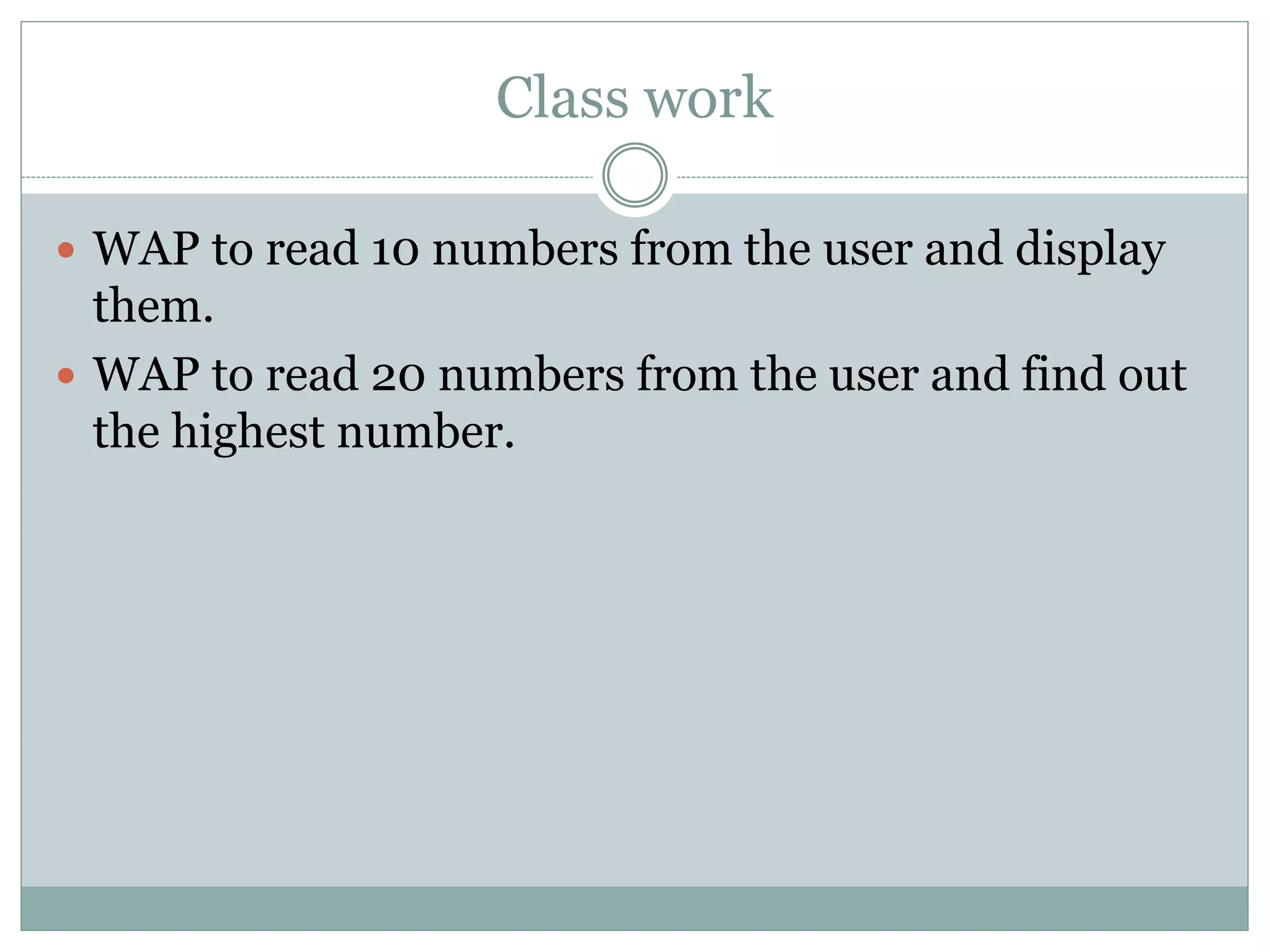
![WAP to read 10 numbers from the user and display them. #include<stdio.h> #include<conio.h> int main () { int a[10]; int i; printf("please enter ten numbersn"); for(i=0;i<10;i++) { scanf("%d",&a[i]); } for(i=0;i<10;i++) { printf("%dt",a[i]); } getch(); }](https://image.slidesharecdn.com/array-170824170507/75/Array-MULTI-ARRAY-IN-C-13-2048.jpg)
![WAP to read 20 numbers from the user and find out the highest number. #include <stdio.h> int main() { int array[20], size, i, largest; printf("n Enter the size of the array: "); scanf("%d", &size); printf("n Enter %d elements of the array: ", size); for (i = 0; i < size; i++) scanf("%d", &array[i]); largest = array[0]; for (i = 1; i < size; i++) { if (largest < array[i]) largest = array[i]; } printf("n Highest element present in the given array is : %d",largest); getch(); }](https://image.slidesharecdn.com/array-170824170507/75/Array-MULTI-ARRAY-IN-C-14-2048.jpg)
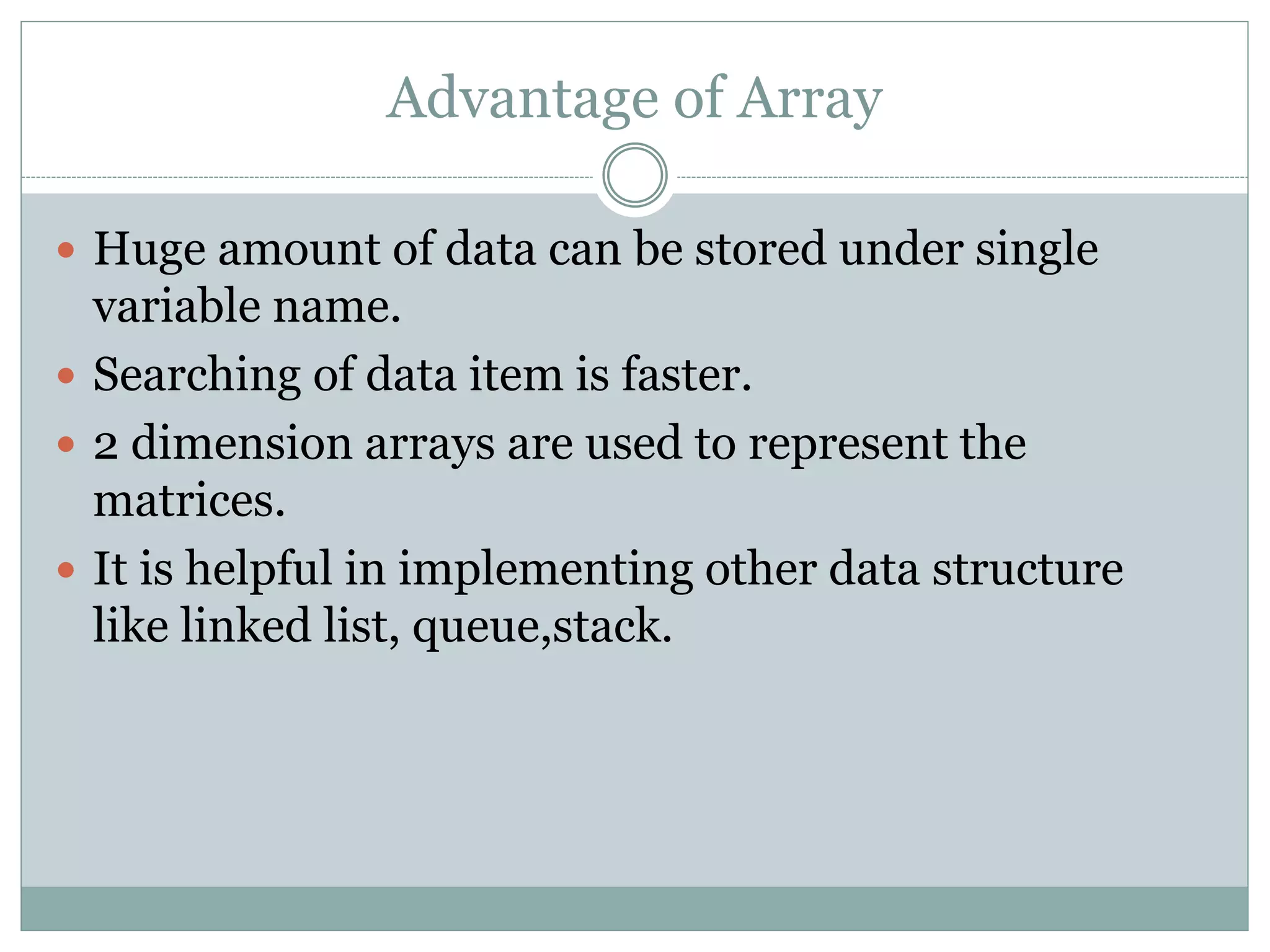
![2-Dimensional Arrays • A collection of a fixed number of components arranged in two dimensions – All components are of the same type • The syntax for declaring a two-dimensional array is: dataType arrayName[intexp1][intexp2]; where intexp1 and intexp2 are expressions yielding positive integer values; e.g., double sales[10][5]](https://image.slidesharecdn.com/array-170824170507/75/Array-MULTI-ARRAY-IN-C-16-2048.jpg)
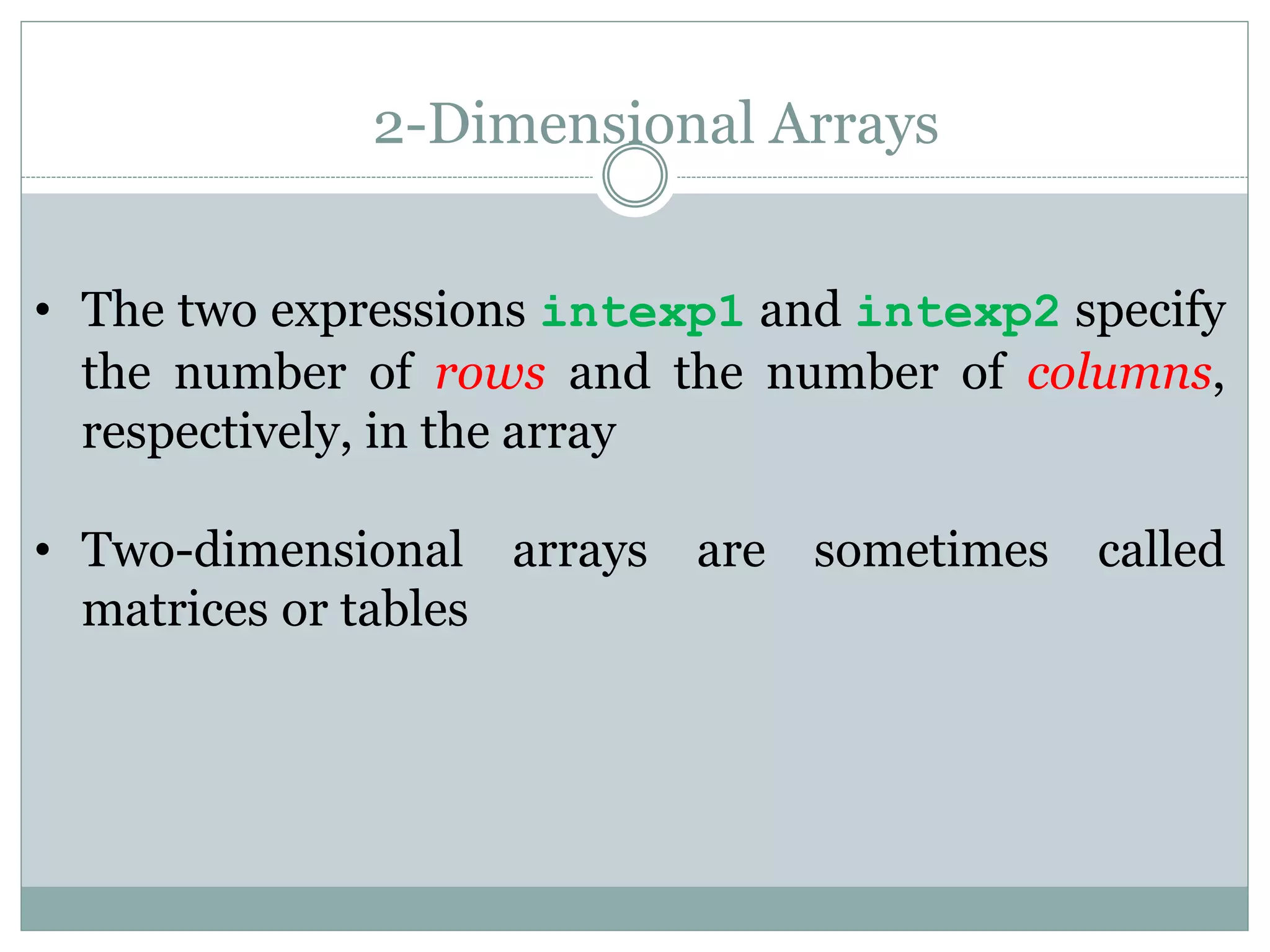
![2-Dimensional Arrays double sales[10][5];](https://image.slidesharecdn.com/array-170824170507/75/Array-MULTI-ARRAY-IN-C-18-2048.jpg)
![2-Dimensional Arrays The syntax to access a component of a two- dimensional array is: arrayName[indexexp1][indexexp2] where indexexp1 and indexexp2 are expressions yielding nonnegative integer values indexexp1 specifies the row position and indexexp2 specifies the column position](https://image.slidesharecdn.com/array-170824170507/75/Array-MULTI-ARRAY-IN-C-19-2048.jpg)
![2-Dimensional Arrays sales[2][3] = 35.60; 35.60](https://image.slidesharecdn.com/array-170824170507/75/Array-MULTI-ARRAY-IN-C-20-2048.jpg)
![2-Dimensional Arrays Accessing Accessing all of the elements of a two-dimensional array requires two loops: one for the row, and one for the column. Since two-dimensional arrays are typically accessed row by row, generally the row index is used as the outer loop. for (int nRow = 0; nRow < nNumRows; nRow++) for (int nCol = 0; nCol < nNumCols; nCol++) printf(“%d”,anArray[nRow][nCol]);](https://image.slidesharecdn.com/array-170824170507/75/Array-MULTI-ARRAY-IN-C-21-2048.jpg)
![2 DIM. Arrays: Example #include<stdio.h> #include<conio.h> int main() { double sales[2][3]; sales[0][0] = 2.3; sales[0][1] = 3.5; sales[0][2] = 4.2; sales[1][0] = 5.6; sales[1][1] = 6.7; sales[1][2] = 7.8; //complete program by //printing the values which look like this:](https://image.slidesharecdn.com/array-170824170507/75/Array-MULTI-ARRAY-IN-C-22-2048.jpg)
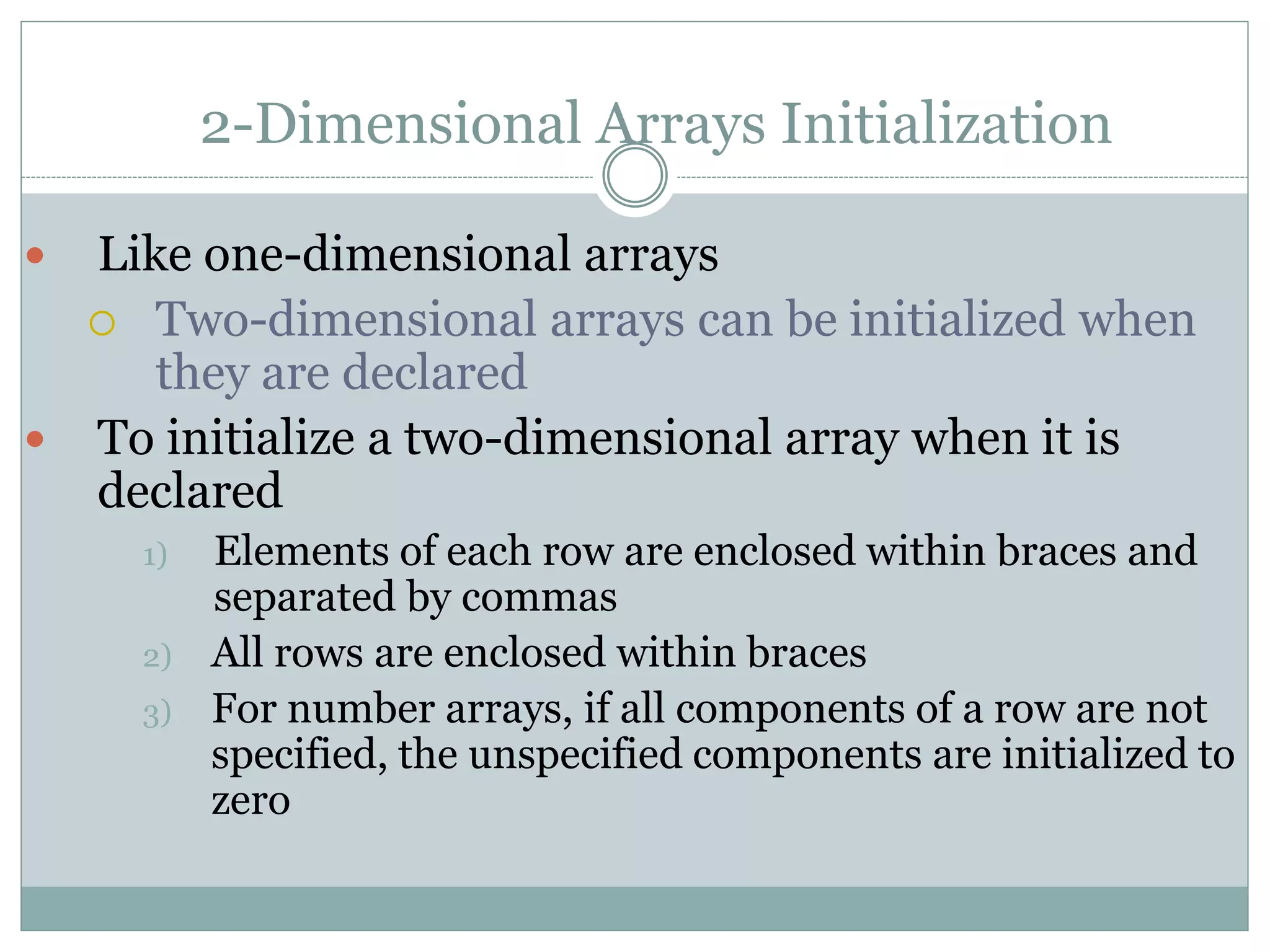
![2-Dimensional Arrays Initialization Example: int anArray[3][5] = { { 1, 2, 3, 4, 5, }, // row 0 { 6, 7, 8, 9, 10, }, // row 1 { 11, 12, 13, 14, 15 } // row 2 };](https://image.slidesharecdn.com/array-170824170507/75/Array-MULTI-ARRAY-IN-C-24-2048.jpg)
![2 DIM. Arrays: Example #include<stdio.h> #include<conio.h> int main() { int matrix[2][2] = { {2,3,}, //row0 {5,7} //row1 }; printf("n Resultant n"); for(int i = 0; i < 2; i++) { for(int j = 0; j < 2; j++) { printf(" %d", matrix[i][j]); } printf("n"); } getch(); }](https://image.slidesharecdn.com/array-170824170507/75/Array-MULTI-ARRAY-IN-C-25-2048.jpg)
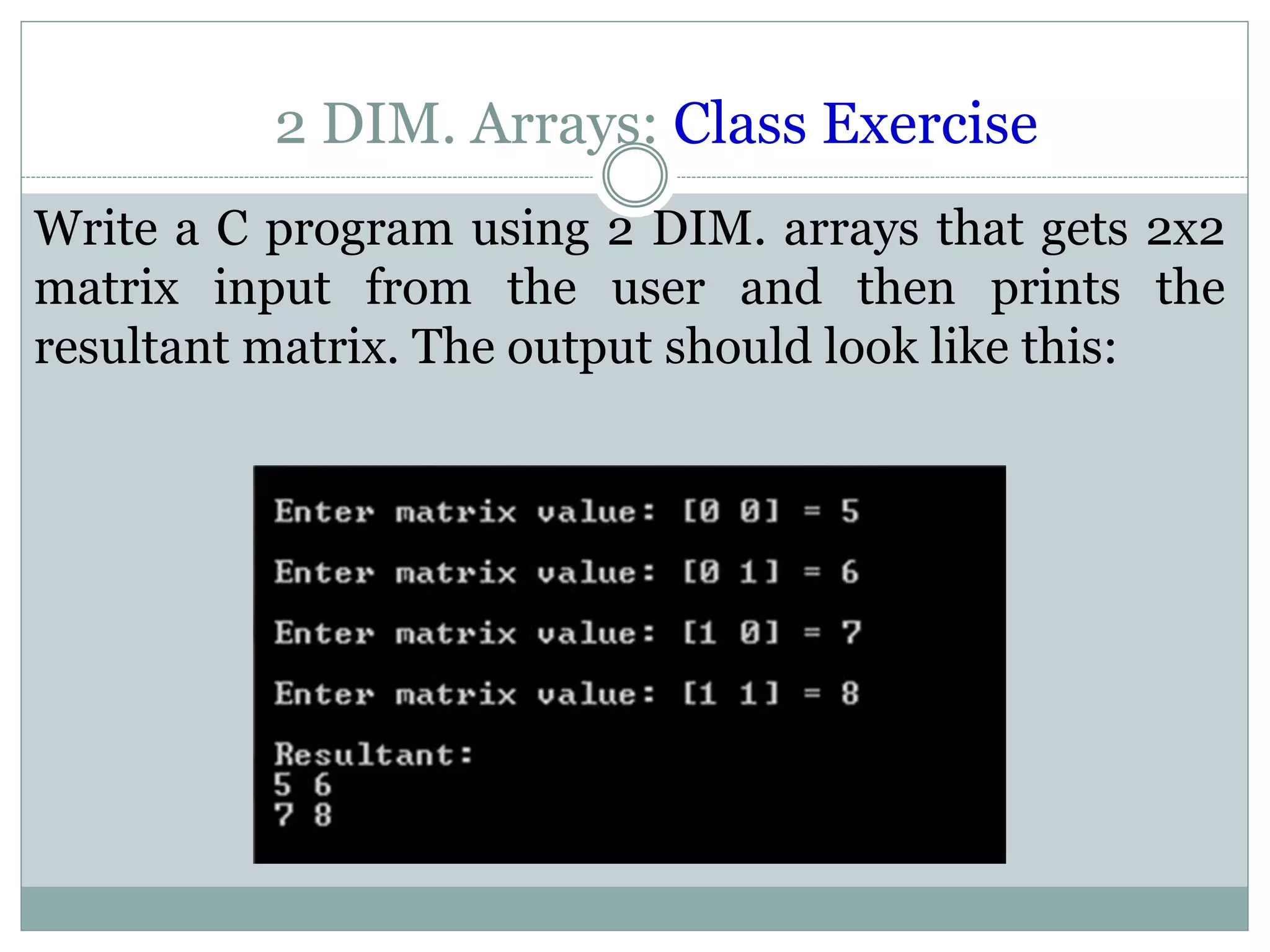
![2 DIM. Arrays: Exercise Solution #include<stdio.h> #include<conio.h> int main() { int matrix[2][2]; for(int i = 0; i < 2; i++) { for(int j = 0; j < 2; j++) { printf("Enter values for [%d %d] ",i,j); printf("n"); for(int i = 0; i < 2; i++) { for(int j = 0; j < 2; j++) { printf(" %d",matrix[i][j]); } printf("n"); } getch();](https://image.slidesharecdn.com/array-170824170507/75/Array-MULTI-ARRAY-IN-C-27-2048.jpg)
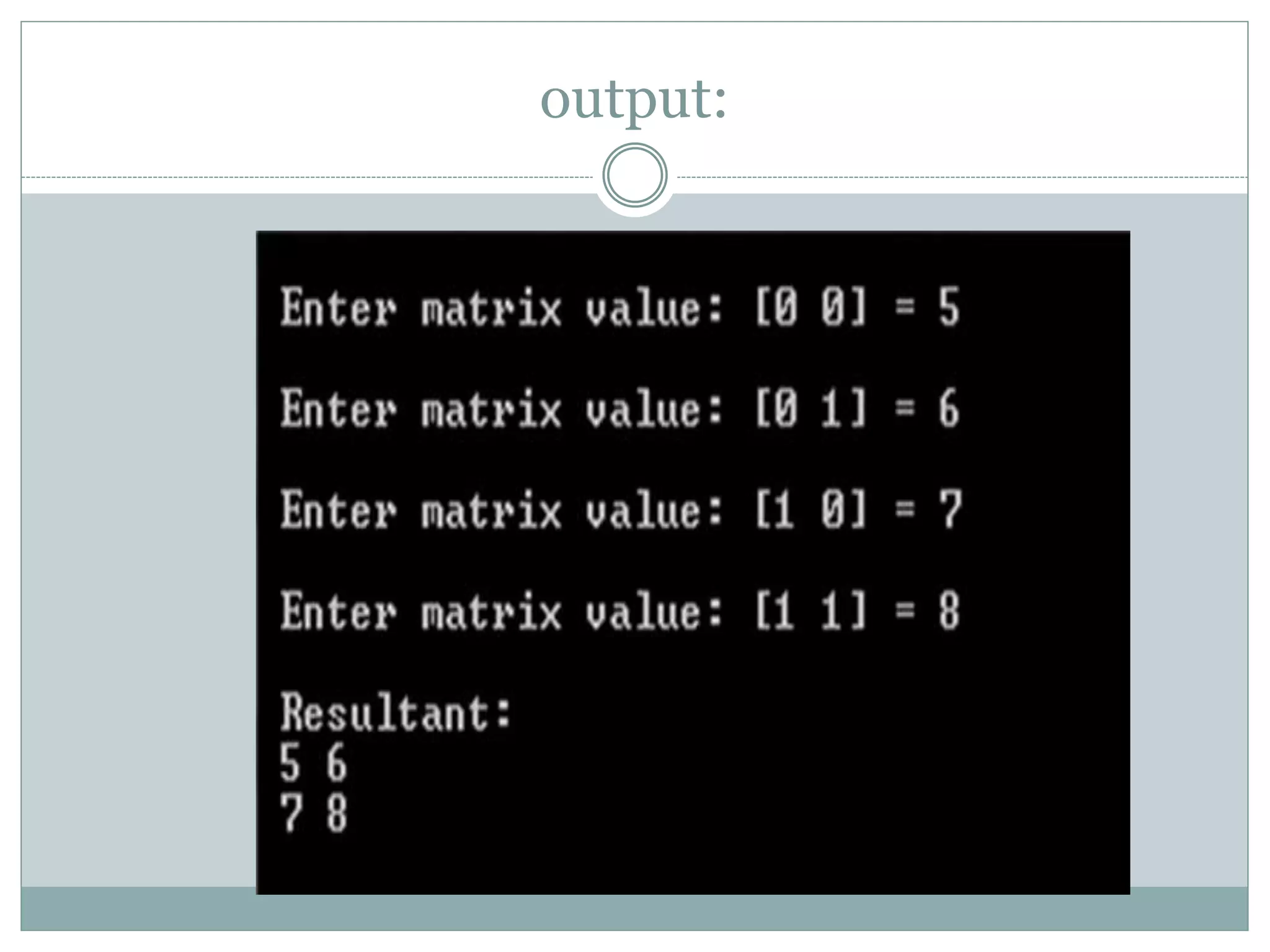
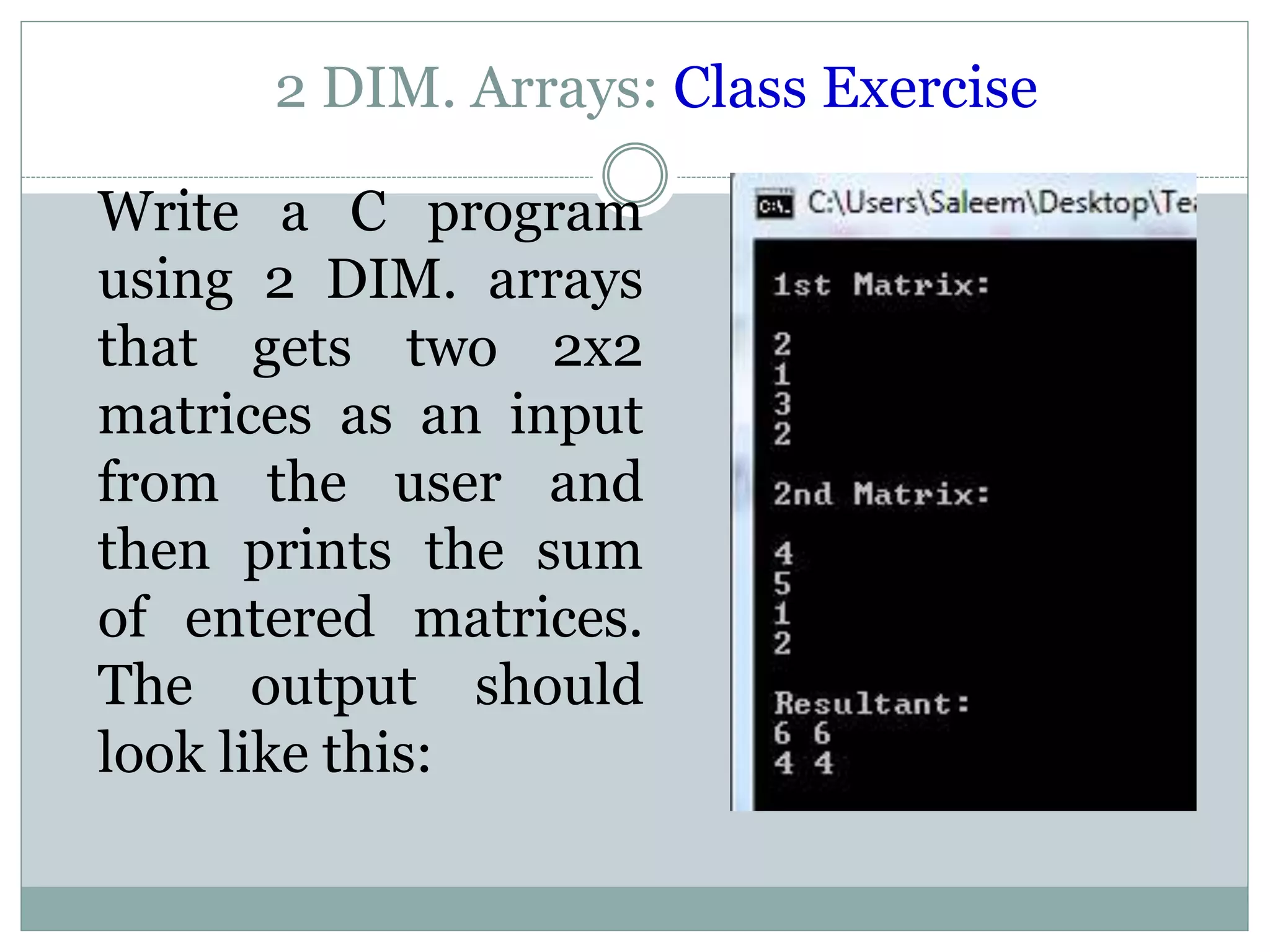
![Ex.1 #include <stdio.h> int main() { int a[2][2], b[2][2],c[2][2]; int i, j; printf("Enter elements of 1st matrixn"); for(i=0; i<2; ++i) for(j=0; j<2; ++j) { scanf("%d", &a[i][j]); } printf("Enter elements of 2nd matrixn"); for(i=0; i<2; ++i) for(j=0; j<2; ++j) { scanf("%d", &b[i][j]); } for(i=0; i<2; ++i) for(j=0; j<2; ++j) { c[i][j] = a[i][j] + b[i][j]; } printf("nSum Of Matrix:n"); for(i=0; i<2; ++i) { for(j=0; j<2; ++j) { printf("%dt", c[i][j]); if(j==1) ; } printf("n"); } return 0; }](https://image.slidesharecdn.com/array-170824170507/75/Array-MULTI-ARRAY-IN-C-30-2048.jpg)
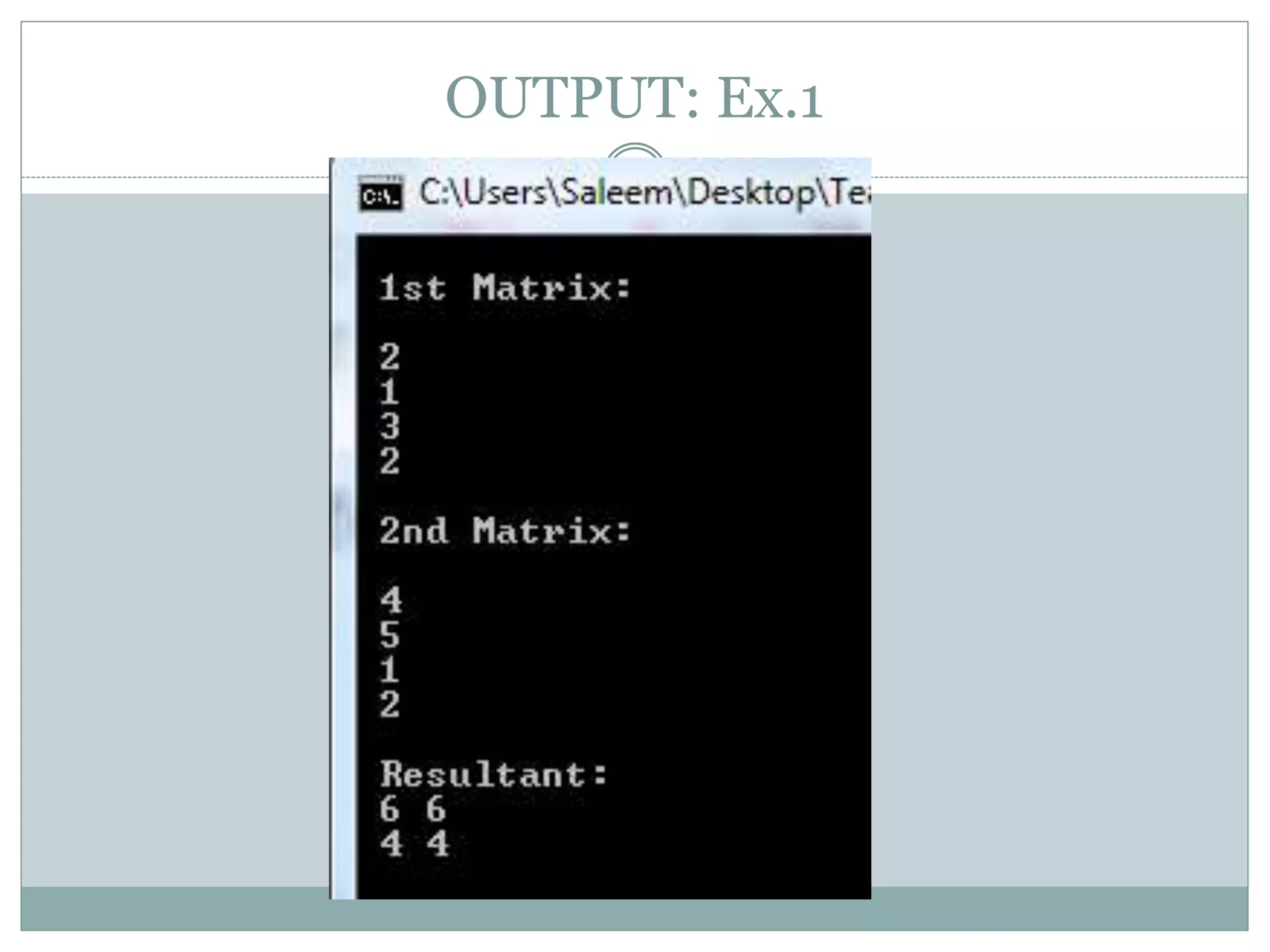
![2 D. Arrays: Write a C program using arrays that produces the multiplication of two matrices.#include <stdio.h> #include<conio.h> int main() { int a[2][2], b[2][2],c[2][2]; int i, j; printf("Enter elements of 1st matrixn"); for(i=0; i<2; ++i) for(j=0; j<2; ++j) { scanf("%d", &a[i][j]); } printf("Enter elements of 2nd matrixn"); for(i=0; i<2; ++i) for(j=0; j<2; ++j) { scanf("%d", &b[i][j]); } for(i=0; i<2; ++i) for(j=0; j<2; ++j) { c[i][j] = a[i][j] * b[i][j]; } printf("n Multiplication Of Matrix:n"); for(i=0; i<2; ++i) { for(j=0; j<2; ++j) { printf("%dt", c[i][j]); if(j==1) ; } printf("n"); } return 0; }](https://image.slidesharecdn.com/array-170824170507/75/Array-MULTI-ARRAY-IN-C-32-2048.jpg)